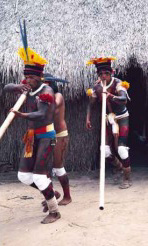home


Many of the Indians can not understand why their land has changed so drastically over the years. One example comes from an Oglala Sioux in North America named Hobart Keith. Keith asked, "Why are there only 8 inches of topsoil left in America, when there were some 18 inches at the time of the Declaration of Independence in 1776? Where goes our sacred earth?(1)" This "sacred earth" that Keith discusses has been destroyed over the centuries by profit minded individuals, countries, business, and corporations who have always looked for ways to make money at the expense of the environment and the indigenous people who live off of the land.
Differing Views of Land: Indians v. Europeans
Destruction of the environment of the Americas
goes all the way back to the conquests of the Europeans and the discovery
of this continent by Christopher Columbus. Typical of many European
explorers, Columbus and his men were too focused on finding gold and other
forms of riches to notice the different types of plants and animals that
they had come across. As a result, these and many other groups of
Europeans destroyed the land and the people in their efforts of finding
valuables in the Latin American jungles(2). It is necessary to investigate
the differing views that were present between the Indians and the Europeans
in terms of the environment.
Indians
*Indigenous cultures usually viewed nature and
the environment as the home of their gods.
*Worshipped nature and had spiritual relationship
with it.
Europeans
*Worshipped a man rather than nature.
*Their God was the center of the universe, not
nature or the environment.
*Saw the land as theirs for the taking, they
had the knowledge so they felt as if they had the rights
to it(3).

Europeans and Environmental
Consequences
The main goal of the European explorers, namely
the Spanish conquistadors, was to supply Europe with natural resources
that they did not have and those which they had grown dependent on.
These products included trees, agricultural products, animals, slaves,
and other types of plants. Europeans also brought over many new forms
of plants and animals that began to fight with the indigenous flora and
fauna for space. Not surprisingly, many of these new arrivals destroyed
the native plants, which effected the indigenous people who had a dependence
on these crops(4).
Haciendas and Plantations
*Needed to clear land for them to be built.
*This land was cleared with little regard for
the preexisting plants and animals.
*"Foreign species without natural predators [were
then] introduced, and other natural species
not conducive to the new crops [were]
suppressed.(5)"
Sugar
*Mostly effected present-day Haiti and the Dominican
Republic.
*These areas were heavily deforested for the
production of sugar, which would become Latin
America's first major cash crop.
Coffee
*These plantations destroyed large portions of
the rainforests in Central America, Colombia,
Venezuela, and Brazil(6).
Cotton
*The main source of destruction in the forests
that lay along the coast of Central America(7).
Wildlife
Many of the animals of Latin America were deprived of food and protection because there no longer an abundance of plants to feed off of. The soil also lost a lot of important nutrients which were vital for the growth of plantlife. Pollution also had a huge effect on the environment resulting in the water supply being ruined and the land becoming infertile. This caused many of the plantations to move out into unsettled areas which perpetuated this vicious cycle of events.
Cattle Ranching
Today cattle ranching is a new form of destruction
on the environment. Cattle has been in the Americas since the arrival
of the Spanish conquistadors.
*There were 150,000 heads of cattle in 1579 in
Mexico.
*At this same time the largest herds of cattle
in Spain numbered 1,000.
*Pigs, goats, sheep, and horses also accompanied
cattle into the New World.
--Previously, they were unknown to the indigenous people.
--The breeding of these animals was uncontrolled allowing for a large number
of
animals.
--They ate and trampled crops.
--Transmitted diseases to the native animals.
*Presently, few indigenous people could survive
without these imported plants and animals(8).
Development of Mining
Mexico and Bolivia
These two areas were deeply involved in the large-scale
silver mining industry. Unfortunately, they took to using large amounts
of mercury in this process. It was this mercury and other elements
of mining that led to the pollution of rivers and the killing of numerous
fish, plants, and animals who fed off of these products. The mercury
still pollutes today, specifically in the Amazon Basin by people in search
of gold(9).
1. Phillip Wearne, Return of the Indian: Conquest and Revival in the Americas, Philadelphia: Temple University Press, 1996: 121-122.
2. Ibid, 123.
3. Ibid, 123-124.
4. Jen Green, Rainforests, New York: Lorenz Books, 1998: 75-77.
5. Wearne, 124.
6. Sophie Chou. "Coffee and Deforestation," World Watch 11 (March/April 1998): 81.
7. Chris C. Park, Tropical Rainforests, New York: Routledge, 1992: 34-36.
8. Ibid, 40.
9. Wearne, 126-127.